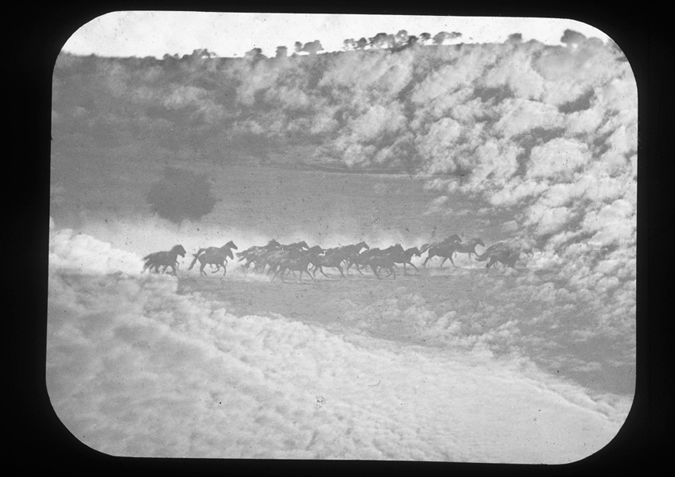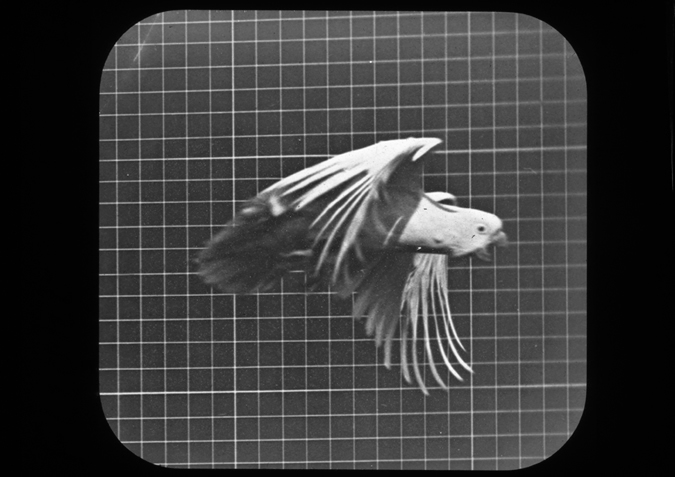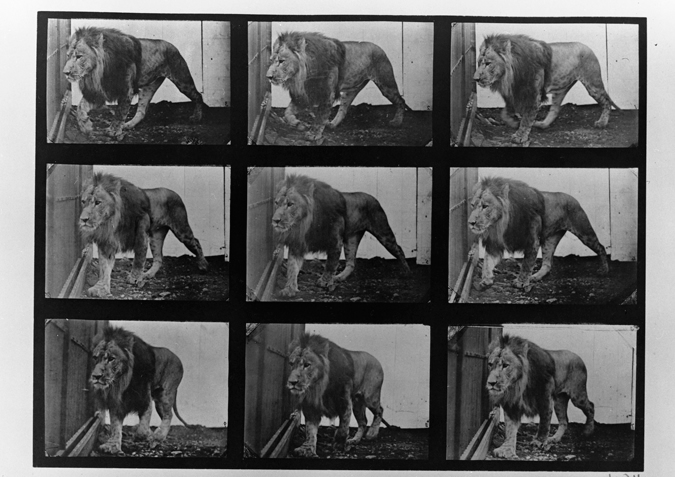Muybridge's photography of horses in motion began in 1872 at Leland Stanford's stock farm in Palo Alto. After one year of intense photography in 1877-8, Muybridge's work continued here intermittently until 1881. Muybridge and Stanford were close acquaintances at the beginning of this partnership. However, this particular business association is said to have started because Stanford wanted to settle a bet around whether all four of a horse's hooves left the ground at speed; something Muybridge's single shot motion photographs of 'Occident' - one of Stanford's trotters - proved correct.
Many believe elements of this story were concocted for press and the public. But regardless of its initial motivations, Muybridge's single shot photography of motion led to his most pioneering body of work, known as motion sequence photography. Here, separate instantaneous images of motion were displayed in a grid illustrating consecutive phases of movement. This photography was highly celebrated in Muybridge's time, and is something many contemporary theorists believe represents a zeitgeist of the 19th Century.
The first motion sequence photographs were taken in 1878 when Stanford asked Muybridge to investigate animal locomotion as a phenomenon in itself. Muybridge set up a battery of 12 cameras at Palo Alto and developed a set of electro-shutters and timers. He then began taking a series of 6, 8 or 12 phases of the horse in motion.
These photographs were received well at home and abroad, leading Muybridge on a tour of Europe and the States and earning him respect and notoriety in both artistic and scientific communities (Haas, 1976, p129). Even after Muybridge's relationship with Stanford broke down in 1883 over the publication of a book taking credit for his work, Muybridge's reputation went untainted.
Indeed, Muybridge's credibility was such that he was soon awarded a contract at Pennsylvania University to continue his work, here concentrating on wild and domestic animals and human beings as well as horses (Haas, 1976, p145). The Pennsylvania contract, one of the first of its kind, would run from May 1884 to January 1886, culminating in over 100,000 images, and the publication of 'Animal Locomotion': a series of 781 plates of locomotion (Brown, 2005, p626).
These images were extremely technically skilled. However, the almost obsessive volume of photographs produced and the positive reception of them by the public also begs a very interesting question about the underlying cultural appeal of Muybridge's motion sequences in the 19th Century; a fascination which seemingly surpassed the pure novelty of seeing motion dissected.
Theorists such as Rebecca Solnit and Tim Cresswell have approached this question in a very interesting way: by focusing on the role of time and its relation to movement in the 19th Century.
To these theorists, the 19th century was a time when everything was shifting, moving and changing. Time was speeding up through mechanised transport, territory was fast expanding and landscapes were changing because of industry. Photography until now had not represented movement because long exposure times displayed it only as a blur. But Muybridge's instantaneous photography made motion visible, and therefore functioned to represent the fast-moving time and shifting cultural landscape of modernity.
In fact, this experience of modern time and motion also had much anxiety attached to it: something else we can see reflected in Muybridge's work (Cresswell, 2006, p70). Muybridge's photographs certainly comment upon the endlessly changing nature of time within modernity. However, in so doing they also 'attempt to capture the fleeting and the invisible' (Cresswell, p83) making it feel comprehensible and safe for the modern audience by dissecting it into manageable chunks.
Perhaps this exchange Muybridge was having with modernity might help us understand the extensive volumes of motion sequences he produced to such great acclaim. Many psychologists believe that in order to master trauma, we repeat this trauma until we feel in control of it. Perhaps this is what Muybridge - and his audience - was attempting here.
Select Bibliography
Brown, Elspeth.H 'Racialising the Virile Body: Eadweard Muybridge's locomotion Studies 1883-1887. In Gender and history Vol 17 no 3 Nov 2005 pp627-656.
Cresswell, Tim 'Capturing mobility: mobility and meaning in the photography of Eadweard Muybridge and Etienne-Jules Marey' On the Move (New York, Routledge, 2006)
Haas, Robert Muybridge Man in Motion (Berkeley, University of California Press, 1976)
Solnit, Rebecca Motion studies: Time, Space and Eadweard Muybridge. (London, Bloomsbury, 2003)

-trot-with-sulky'-EM6782.jpg)
-EM8152.jpg)


 Introducing Muybridge
Introducing Muybridge Landscape
Landscape The Modern City
The Modern City Transport and Trade
Transport and Trade Foreign Bodies
Foreign Bodies Animal in Motion
Animal in Motion Human Figure in Motion
Human Figure in Motion Zoöpraxography
Zoöpraxography